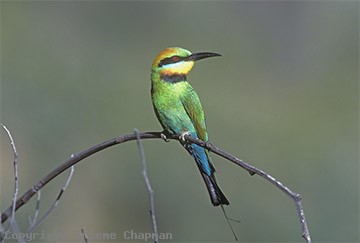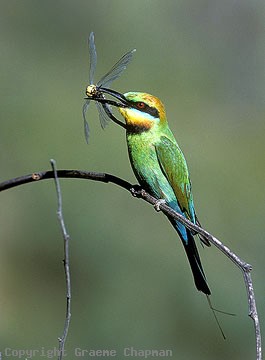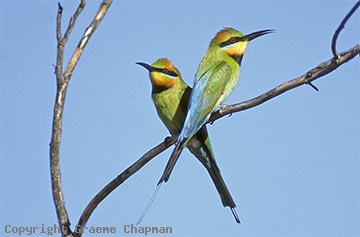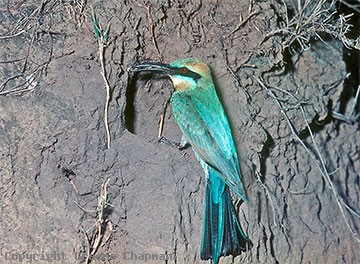Australian Birds
Rainbow Bee-eater
Merops ornatus
(Viewing 4 of 11 photos)
|
Australia has only one bee-eater - more's the pity for they are one of our most beautiful birds. In southern Australia they are summer migrants, arriving in Sept.-Oct. and leaving in Feb.-Mar. Here in the Glasshouse Mountains in Queensland they are present all the year round, presumably the same birds but that's not easy to prove. You can hear them feeding high in the air over the top of the mountain near our house - woodswallows are up there as well so there must be an attractive food source up in those air currents. Certainly the same nesting territories are occupied year after year and subsequent nest holes are often only a few metres apart. In the breeding season the pairs roost together at night in their burrows but in winter here at Beerwah they have a communal roost in a patch of eucalypts on the golf course - the same site is used year after year (pic#329207D). Once they are at roost in the canopy they are remarkably well camouflaged. There have been more than 100 birds in this roost at times. This pales into insignificance compared with a roosting flock I saw many years ago in the N.T. at Kapalga Station. I first noticed them as they flew down to sunbathe late in the afternoon - dozens of them lining up along the wires of a fence before dropping down to a patch of warm bare earth, a superb spectacle in the late afternoon light. Where are the pictures? I wish! They all eventually gathered in some nearby trees and there must have been more than 1000 birds - large flocks are very difficult to estimate.
I once observed an interesting mating display of Rainbow Bee-eaters. The pair sat very close together (touching) on a branch and calling, the male with his crown feathers raised (pic# 329208). He then flew straight up in the air a few metres and appeared to loop the loop to land from behind right beside her again. Lots of calling and raising of crown feathers and all this happened several times until finally he landed and vigorously beat her rear end with his tail, at which time she bowed low on the branch (pic#329209) and then they copulated.
Recently I was lucky enough to see an unusual event at a large communal roost near Mataranka in the N.T. What I estimated to be about 1000 bee-eaters were hoverering and circling around an intended roost site in the crown of a tall paperbark, probably 20 metres high and lurking in the foliage waiting for them was a White Goshawk! Such a sight you remember forever.
Like some of the other bee-eaters in the world, Rainbow Bee-eaters are fairly sociable and sometimes several birds may attend the nest.
|

329202 ... Rainbow Bee-eater, male. |

329203 ... Rainbow Bee-eater, male |
 |

329204 ... A mated pair, male on the right with long tail feathers. See also TOP SHOT LP-120. |

329206 ... The nest tunnel can be a metre or so long - both birds use it for roosting in the breeding season. |
 |
Previous 1 2 3 Next
Return to Photo Library page




